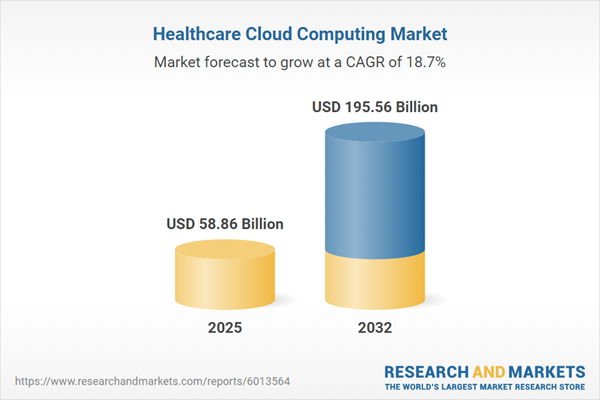Speak directly to the analyst to clarify any post sales queries you may have.
The healthcare cloud computing market is undergoing significant transformation as organizations shift towards digital-first strategies, creating opportunities to elevate care delivery, operational efficiency, and data-driven decision making.
Market Snapshot: Healthcare Cloud Computing Growth Trajectory
The healthcare cloud computing market grew from USD 49.73 billion in 2024 to USD 58.86 billion in 2025. It is projected to continue expanding at a CAGR of 18.66%, reaching USD 195.56 billion by 2032.
Scope & Segmentation of the Healthcare Cloud Computing Market
This report provides a comprehensive analysis of industry dynamics, segmented across organization size, service models, deployment models, end users, applications, and geographic regions.
- Organization Size: Large enterprises; small and medium enterprises
- Service Model: Infrastructure as a Service, Platform as a Service, Software as a Service
- Deployment Model: Hybrid cloud, private cloud, public cloud
- End User: Clinics, diagnostic centers, hospitals, pharmacies
- Application Type: Administrative information systems, clinical information systems, image management and archiving, remote patient monitoring
- Administrative Information Systems: Billing and revenue cycle management, human resource management, supply chain management
- Clinical Information Systems: Clinical decision support systems, computer physician order entry, EMR/EHR (acute and ambulatory), laboratory information systems (pathology and radiology)
- Image Management & Archiving: Picture archiving and communication systems, vendor neutral archives
- Remote Patient Monitoring: Telehealth, wearable device monitoring
- Regional Coverage: Americas (North America, Latin America), Europe, Middle East and Africa, Asia-Pacific
- Key Companies: Amazon Web Services, Microsoft, Google, IBM, Oracle, SAP, Salesforce, VMware, Cisco Systems, Hewlett Packard Enterprise
Key Takeaways for Healthcare Cloud Computing
- Healthcare organizations are prioritizing cloud-native platforms to support interoperability and agile IT transformation across clinical, operational, and administrative workflows.
- Growth in remote monitoring, telehealth, and data analytics accelerates the adoption of scalable cloud infrastructure supporting new models of care delivery.
- Stakeholders are leveraging platform and software as a service to reduce legacy IT burdens, streamline system integration, and enable rapid application development.
- Hybrid and multi-cloud strategies are favored by institutions that balance compliance demands, data sovereignty, and security requirements while seeking flexible resource allocation.
- Strategic partnerships among cloud vendors, software companies, and device manufacturers drive end-to-end connectivity, enhancing real-time clinical engagement and access to actionable insights.
- Regional variations are significant, with regulatory frameworks, infrastructure maturity, and data residency rules shaping cloud adoption rates and deployment models globally.
Regional Tariff Impact
Recent United States tariffs on imported hardware and software components are influencing cloud service provider input costs, affecting contract structures and driving organizations to refine sourcing and procurement strategies. Cloud operators are increasingly pursuing local manufacturing and supply chain initiatives, while providers seek bundled agreements that mitigate the volatility introduced by tariff changes.
Methodology & Data Sources
Insights are drawn from primary interviews with senior healthcare and IT decision-makers, complemented by secondary research of regulatory documents, industry papers, and technical publications. Quantitative data assessment and multi-stakeholder validation ensure findings reflect both market realities and practitioner viewpoints.
Why This Report Matters
- Gain actionable intelligence to inform digital transformation strategies in healthcare cloud computing and address interoperability and compliance goals.
- Understand evolving technology adoption, market segmentation, and the potential impact of geopolitical events such as tariffs on procurement and operational models.
- Leverage peer-driven insights and robust data analysis to evaluate vendor positioning, partnerships, and innovation priorities for long-term competitive advantage.
Conclusion
The healthcare cloud computing landscape is advancing rapidly, opening new opportunities for operational excellence, regulatory alignment, and patient-centered innovation. Organizations equipped with the right insights can drive sustained success in a dynamic market environment.
Additional Product Information:
- Purchase of this report includes 1 year online access with quarterly updates.
- This report can be updated on request. Please contact our Customer Experience team using the Ask a Question widget on our website.
Table of Contents
3. Executive Summary
4. Market Overview
7. Cumulative Impact of Artificial Intelligence 2025
Companies Mentioned
The companies profiled in this Healthcare Cloud Computing market report include:- Amazon Web Services, Inc.
- Microsoft Corporation
- Google LLC
- International Business Machines Corporation
- Oracle Corporation
- SAP SE
- Salesforce, Inc.
- VMware, Inc.
- Cisco Systems, Inc.
- Hewlett Packard Enterprise Company
Table Information
| Report Attribute | Details |
|---|---|
| No. of Pages | 194 |
| Published | November 2025 |
| Forecast Period | 2025 - 2032 |
| Estimated Market Value ( USD | $ 58.86 Billion |
| Forecasted Market Value ( USD | $ 195.56 Billion |
| Compound Annual Growth Rate | 18.6% |
| Regions Covered | Global |
| No. of Companies Mentioned | 11 |









